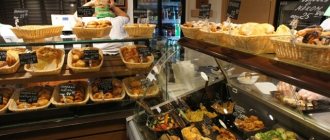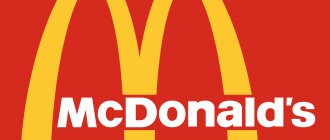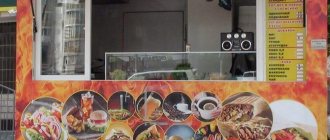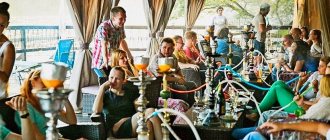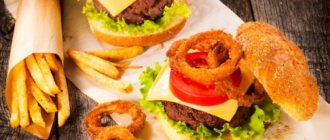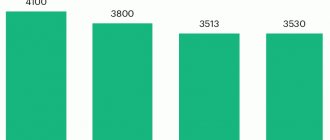Business plan for fish farming (using the example of the Tambov region)
Fish is a wonderful product, especially valuable for its nutritional value. Since ancient times, humanity has loved it for its high taste and nutritional qualities.
Fish is an excellent supplier of animal proteins necessary for the full growth and functioning of all cells and organs of our body. Unlike meat products, fish protein contains much less connective fiber, so it is much easier to digest and digests fairly quickly. In addition, fish contains much fewer calories than the same meat, which is why it is suitable even for those who are struggling with excess weight. In terms of its quality indicators, fish protein is in no way inferior to meat protein; it contains the same essential acids, including tauric acid, which prevents the development of nervous and cardiovascular diseases.
Another important advantage of fish is the large amount of healthy fatty acids it contains. Thanks to them, all lovers of such food are, as a rule, the owners of excellent vision, strong nerves, a healthy heart and low cholesterol levels. In addition, tumor diseases are very rarely found in them, and they live an order of magnitude longer than meat-eaters.
Pond fish farming in its structure and content is not much different from livestock farming. The pond is the same farm.
Select the appropriate option
| Standard | Advanced with financial calculations with Excel financial model | Expanded with adjustments |
| Standard business plan | Advanced trout business plan with full business analysis and financial plan for 5 years | Advanced trout business plan with full business analysis and financial plan for 5 years |
| Detailed financial model of trout | Detailed financial model of trout | |
|
| |
| Adjustment of the business plan to your numbers by our analysts within 5 working days | ||
| Business plan volume: 30 pages. | Business plan volume: 80 pages. | Business plan volume: 80 pages. |
| 10,000 rub. | 20,000 rub. | 39,000 rub. |
| RUB 1,390 | RUB 2,950 | RUB 24,990 |
| Buy | Buy | Buy |
This kit is ideal for those who need a business plan to obtain a loan or attract investment.
Description
The advanced business plan includes a trout financial model in Excel format.
The business plan was developed taking into account the practice of evaluating projects in Russian banks, as well as taking into account the requirements of investors and funds for supporting entrepreneurship in the Russian Federation. It will allow you to substantiate management decisions on investing in the creation and development of trout, predict its financial results and assess risks.
A full description of the business plan can be downloaded from the link:
Description of the trout business plan.pdf
Contents
To familiarize yourself with the contents, download the file:
Description of the trout business plan.pdf
Tables and graphs
To view the list of tables, graphs and diagrams, look at the file:
Description of the trout business plan.pdf
Payment and delivery
You can pay in the following ways:
- Bank cards (Russia)
- Electronic money
- Terminals and communication salons
- Money transfers
- Bank cards (International)
Sending a business plan and financial model:
Sending is carried out within 24 hours after payment to your email address.
Business organization
Trout is an extremely healthy fish, contains a large amount of vitamins and amino acids, promotes good metabolism, normal functioning of the brain, nervous system and heart. The taste of fish also determines the high consumer properties of the product. Despite the fairly high price of trout, the demand for it is constantly growing. Therefore, the trout breeding business is a strategically correct direction of entrepreneurship. The process is not without its challenges, which is why you will need a quality trout business plan.
Stages of work to start a business:
- Studying the basic aspects of business.
- Raising funds to organize a fish farming business.
- Finding a place to house the farm.
- Construction of the necessary structures and premises for the normal functioning of the trout farm.
- Purchase of equipment, technologies and tools, installation.
- Attracting personnel.
- Purchase of fry and feed.
- Start of work on trout breeding.
There are a large number of trout species, but in Russian conditions the most common are rainbow and brook trout (trout). The permissible temperature for keeping fish ranges from +3°C to +24°C. Trout is bred both in natural and artificial reservoirs, including cages, pools and using the ultrasound system. The choice depends on your personal preferences, the availability of a suitable territory and, most importantly, financial capabilities. The ultrasonic system is quite expensive to implement, although it has a wide range of benefits for trout farming. The business plan contains detailed information about the pros and cons of each option.
Market analysis and description of a trout breeding project
The market for domestic fish production, including trout, is growing slowly but surely. Experts believe that favorable conditions have now been created for the development of this type of business and the market growth rate will increase. A ban on the export of food products from a number of countries, state assistance in the field of agriculture are prerequisites for the development of your business.
Produced goods/services
Fresh and frozen trout, caviar, fish seeding material, paid fishing, etc.
Potential clients
Wholesale and retail trade networks, markets, fairs, catering establishments, individuals.
Below are calculations for an example of a ready-made business plan for trout farming in UZD.
Financial part of a business plan for trout farming
Investments:
| Attachments | Deadlines | Amount, thousand rubles |
| Paperwork and registration | 1 month | xxx |
| Rent of land (for the first time) | 3 months | xxx |
| Obtaining permits | 1 month | xxx |
| Construction of the necessary premises, rooms for freezing | 2 months | xxx |
| Purchase of machinery, equipment and inventory necessary for the work, installation, including RAS installations | 2 months | xxx |
| Purchasing fry | 2 weeks | xxx |
| Purchase of feed for 3 months | 2 weeks | xxx |
| Installation of ventilation, electricity, sewerage systems | 1 month | xxx |
| Marketing events | 3 months | xxx |
| Other costs | — | xxx |
| Total | xxx |
According to the business plan of the trout farm, investments in the business will amount to about 15 - 20 million rubles.
Income:
| Source of income | approximate price | Sales volume, per year (average) | Amount of revenue, thousand rubles per year |
| Selling fresh trout wholesale | xxx | xxx | xxx |
| Sale of fresh frozen trout wholesale | xxx | xxx | xxx |
| Retail sale of fresh and frozen trout | xxx | xxx | xxx |
| Other income | xxx | ||
| Total | xxx |
Average revenue will be about 16 - 22 million rubles annually (production capacity for 30 - 35 tons of fish).
Expenses:
| Expenses | Amount per year, thousand rubles |
| Rent of land | xxx |
| Feed base | xxx |
| Remuneration of personnel, social services. contributions | xxx |
| Taxes, loan servicing (interest) | xxx |
| Marketing events | xxx |
| Communal payments | xxx |
| other expenses | xxx |
| Total | xxx |
Annual expenses average 10–15 million rubles.
Profit, payback and profitability of the business:
| Index | Meaning |
| Profit, thousand rubles | 5650 |
| Profitability | 30% |
| Payback period | 3 years |
The payback period of the project is about 3 years, the profit is on average 4 - 8 million rubles, and the profitability is 30%.
Conclusions:
Trout farming, despite being a labor-intensive process, is considered one of the most profitable business options in the fishing industry. Regardless of whether you are planning a trout cage or RAS business, you will need a quality business plan that will take into account your choice.
Fish farming business plan
The only thing that differentiates a livestock farm from a fish farm is the environment.
Pond fish farming as a traditional form of fish farming is one of the sources of commercial products in the form of live and fresh fish. The further development of pond fish farming is facilitated by its high economic efficiency. An increase in fish production can be achieved not only through further intensification of pond fish farming in existing areas, but also through the construction of new reservoirs on small rivers.
It is known that pond fish, which has a low cost, but is not inferior in quality to sea and ocean fish, can replace the latter, which will additionally create conditions for improving the nutritional structure for the population. Carp, tench, crucian carp, grass carp, silver carp, pike, and pike perch are well bred in homestead ponds.
Economic aspects of a business plan for financing a trout farm
Operating expenses
The total volume of operating expenses and their structure, to determine the economic efficiency of the trout farm investment project:
- utility bills and payment for services of energy supply companies - XXX rubles;
- rent and cost of use of land and water resources – XXX rub.;
- feed – XXX rub.;
- maintenance of technological installations – XXX rub.;
- calculated depreciation for the reporting period – XXX rub.;
- expenses for promotion and distribution – XXX rub.;
- wage fund – XXX rub.;
- taxes and fees – XXX rub.
The total cost of ensuring operating activities according to investment plan trout breeding will be XXX rubles. per month.
Section of the business plan for a separate trout farm dedicated to revenue and sales income
Based on consumer preferences, it is necessary to determine those qualities of the finished product that will contribute to achieving the planned profitability from the implementation of a business plan for financing a trout farming enterprise :
- optimal size;
- freshness and naturalness of farmed trout ;
- proximity to the consumer;
- reasonable prices.
Sales split:
- Chilled products – XXX rub.
- Frozen fish – XXX rub.
- Sets of varying degrees of cutting – XXX rub.
The amount of monthly revenue included in the trout farm will be XXX rubles.
Determination of the number of employees and the size of the wage fund
Such fish farms are quite capable of managing with a minimum staff - the main thing is the correct organization of labor and obtaining maximum productivity from each staff unit.
An example of a trout farm :
- manager – XXX rub.;
- specialist in breeding trout fish – XXX rub.;
- accountant – XXX rub.;
- HR specialist – XXX rub.;
- food production technologist – XXX rub.;
- workers - XXX rub.;
- Marketing and Sales Department – XXX rub.;
- maintenance and office staff - XXX rub.
Breeding crucian carp.
Crucian carp is a typical pond fish. There are golden crucian carp (in ponds) and silver crucian carp (in flowing water bodies). They differ only in external coloring and some morphological characteristics. It should be noted that crucian carp are one of the most valuable fish breeds when bred by amateur fish farmers in small reservoirs, since they are not very demanding on the oxygen regime. However, it is necessary to constantly regulate their reproduction in order to prevent overpopulation of the reservoir and reduction of the mass.
Golden crucian carp is a strong competitor to carp in nutrition, so it is not recommended to grow them in the same pond. For joint cultivation, it is better to take silver crucian carp.
Which equipment to choose
Growing in pools is the best option if it is impossible to arrange an artificial pond. You will need the pool itself, a pumping system, filtering and feed dispensing mechanisms. The construction of a small swimming pool will require about 100 thousand rubles.
Breeding fish in ponds, artificial or natural. Natural - needs to be cleaned and prepared to launch the fry. Cage farming as a business is no longer so popular. This type of fish farming is rather amateurish; it can be organized in your garden for exotic purposes and for your own consumption.
Breeding of White Cupid.
Grass carp is a typical herbivorous fish. An adult eats various aquatic vegetation of ponds - 30-70 kg. per 1 kg. growth. The fry feed on crustaceans and rotifers. If there is little vegetation, it can compete with carp in nutrition, even eating mixed feed. Therefore, they are planted in overgrown ponds at the rate of 100-300 pieces per hectare of water surface.
Sexual maturity occurs at 6-8 years. Spawning in natural conditions has not been observed - this is an artificially propagated fish. To produce offspring, breeders are kept in special ponds or pools with warm water. After fertilization, the eggs are washed with clean pond water and placed in incubation apparatus for 18-32 hours. The embryos that hatch from the eggs fall by gravity into special catch cages. They are kept in the apparatus until the transition to mixed feeding. Later they go to ponds for growing or sale.
Feeding
The main expenses of this business are related to trout feeding. The quality of the food affects the taste of the fish meat, so you shouldn’t skimp on it. The reddish color of the meat comes from krill, which is contained in special bait mixtures. In addition, the diet should contain proteins.
Young individuals are fed every hour. An automated power supply system helps to maintain this regime. Adults are fed 4-5 times a day. The daily ration of trout depends on the breed and conditions of detention, but should not exceed 10% of its weight.
We also have a business plan for carp breeding, more details here:
Silver carp breeding.
There are two types - white and motley, differing in color, growth, and feeding method.
Silver carp feeds exclusively on microscopic algae, while bighead carp also feed on zooplankton. The growth of silver carp is somewhat less than its counterpart. There are bighead carp weighing up to 28, and white carp weighing up to 16 kg. Bighead carp forms hybrid forms with silver carp. The production rate per 1 hectare of feeding pond is 500-1000 yearlings, depending on the food supply.
Amount of financing of a business plan for investing in a trout breeding company
In most cases, the larger the scale of the planned business, the more expensive it will be to organize it. And therefore, the fate of the entire company largely depends on how competently and professionally your project is drawn up, in terms of its investment attractiveness. From our website you can prepare a structured business plan for trout farming , with the necessary calculations of the main financial and economic indicators that justify the financial attractiveness of your idea. This will allow you to avoid difficulties at the stages of project protection and properly launch your business.
Financing structure:
- arrangement of the site and pond system - XXX rub.
- purchase and installation of all systems and equipment – XXX rub.
- formation of food supply - XXX rub.;
- purchase of trout fry for breeding – XXX rub.;
- advertising campaign at the start of sales - XXX rub.;
- search and hiring of employees;
- reserve funds – XXX rub.
In general, to fully implement the business plan trout farming enterprise , you will need from 50 to 120 million rubles.
Technologies and basics of material support
As for the stages of the fish farming process itself, they can be formulated in the following sequence: stocking ponds, feeding and monitoring weight gain processes, catching commercial fish, processing and packaging, sending to distribution points and customers.
Equipment for implementing the technical side of a business plan for a trout farm:
- fences, feeders and cages;
- water supply, filtration, pond drainage systems;
- instrument for taking samples;
- devices for dosed feeding;
- fishing equipment;
- cutting and packaging line;
- freezers and refrigerators.
Catfish breeding.
Compared to other predatory fish (pike, pike perch), catfish has a number of important advantages. Catfish do not need large bodies of water and can successfully feed in small ponds, pits, canals, and quarries with good hydrochemical conditions. Thanks to the tendency to hibernate, the wintering of catfish is greatly simplified - there is no need to keep fish in ponds to feed it, as when wintering pike and pike perch.
Russia has all the conditions for the rapid development of various areas of aquaculture. The country has significant water resources. The total area of inland water bodies exceeds 25 million hectares, including the area of lakes - 20 million hectares, reservoirs - 4.5 million hectares, complex reservoirs and ponds - about 1 million hectares. A large number of fish pond farms and industrial fish farms, a well-functioning system of artificial reproduction, proven technologies in various areas of cultivation of aquatic organisms, the presence of qualified specialists - all this is the basis for the effective development of aquaculture in the Russian Federation. In analyzes of the current state and future of freshwater aquaculture in Russia, pond fish farming in the past and at the present stage, in terms of production volume and efficiency, among other areas of commercial fish farming, such as industrial, lake and pasture, occupies a leading position. In the total production of marketable fish in freshwater aquaculture, the share of pond fish farming currently exceeds 63%.
There are more than 900 ponds and reservoirs in the Tambov region. About 90 ponds are leased from legal entities and individuals who use them for fish farming in accordance with the Water Code of the Russian Federation.
In 2020, just over 500 thousand tons of fish products were imported to Russia, which is more than 2 times less than in 2014. Basically, fish is brought from China, Korea, the Netherlands, as well as from Japan and Belarus.
The All-Russian Association of Fisheries Enterprises does not see anything wrong with reducing fish imports, since this plays into the hands of domestic companies.
According to Tambovstat data, 11.9 thousand tons of fish and fish products were produced in the Tambov region. Based on the norm of consumption of products of this type recommended by the Ministry of Health of the Russian Federation (24 kg per year per person), the annual production volume for self-sufficiency of the region should be at the level of 25.2 thousand tons. Based on this, the deficit in the production of fish and fish products in the region is 52.7%. This indicator can be calculated based on the consumption of basic food products by the population of the Tambov region. According to officially published data from Tambovstat, consumption for the group fish and fish products is at the level of 11.3 kg. per year per person, which is 47% of the norm recommended by the Ministry of Health of the Russian Federation, so the production deficit is also at the level of 53%.
Based on an analysis of current market trends, the commercial fish production segment has sufficient capacity. The products planned for production in the peasant farms are in good demand among the population of the Rzhaksinsky district and the Tambov region as a whole.
READ MORE INFORMATION ABOUT FISH CULTURE IN THE FISH CULTURE AND AQUACULTURE SECTION
BUSINESS PLAN “POND FISH CULTIVATION” WITH CALCULATIONS. (AUTHOR TAMBOV RICC APK)
BUSINESS PLAN “Fish farming” WITH CALCULATIONS. (AUTHOR GBU SO IKS APK Saratov Region)
fish farming
Financial plan
This is one of the most important sections of a business plan. It can have different shapes and appearances. However, no matter how you design it, the investor should understand: income, expenses, profitability and payback period of the project.
Sample financial plan
Projected Costs
Costs at the initial stage (amount in rubles):
- Equipment for a closed water supply installation (RAS) – 950 thousand rubles.
- Construction of necessary communications – 70 thousand rubles.
- Repair of existing premises - 35 thousand rubles.
- The cost of obtaining permits is 25 thousand rubles.
- Purchase of auxiliary equipment and workwear – 30 thousand rubles.
- Unforeseen expenses – 25 thousand rubles.
- Purchase of juvenile fish – 33 thousand rubles.
Total: 1,168 thousand rubles.
Regular expenses (amount in rubles):
- Renewal of fish stock - 35 thousand rubles.
- Salary (according to the staffing table) – 336 thousand rubles.
- Social security contributions (monthly) – 100.8 thousand rubles.
- Food and medications – 110 thousand rubles.
- Payments for energy resources and utility bills – 45 thousand rubles.
- Transport costs – 53 thousand rubles.
- Other regular expenses – 25 thousand rubles.
Total: 704.8 thousand rubles or 58.73 thousand per month.
Revenue forecast
- Market price is 130 rubles/kg of fish.
- The planned sale of fish per year is 10 thousand kg.
- Trade revenue – 1,130 thousand rubles per year.
- Fisheries profit: 425.2 thousand rubles.
- Profitability: 39.7%.
- Payback of the project (sum of initial costs/profit per month): approximately 33 months.
Intensive commercial fish farm with the organization of commercial fishing
Along with purely fishing, it can be a very profitable form of doing business. It combines the features of commercial and fishing farms, but has its own characteristics. During the transition to a market economy, this form of fish farming helped many fish farms survive. Currently, it is becoming increasingly widespread among large and medium-sized fish farming enterprises. Allows you to receive real payment for products not only in the fall, but also in the summer months. The rhythm of production and its efficiency increases due to the reduction of losses from poaching, which is at least partially channeled into the civilized channel of paid fishing. This form is also quite suitable for small fish farms. In this case, it is more profitable to purchase not yearlings in the spring, but two-yearlings, the weight of which, even when planted in feeding ponds in April, is 150 - 200 g/individual. Already in June, some of them, the fastest growing individuals, reach marketable weight. From this time (beginning - mid-June) paid fishing on ponds can be allowed. This lengthens the fishing season and increases profits.
With the rational organization of commercial fishing, in addition to the net profit from the sale of licenses, the costs of catching fish from ponds in the fall, since there is less of it, and for its sale are reduced. A decrease in supply during the final fishing period in September-October allows pond fish farms to maintain an acceptable price level for their products, rather than giving them away for next to nothing to enterprising resellers, which also increases production efficiency. In addition, with an intensive method of farming, the volume of revenue and net profit directly depends on the volume of products produced. The combination of paid fishing and commercial fish farming can significantly increase the amount of fish grown and sold, and, consequently, the profit received. This happens due to an increase in planting density.
It should be borne in mind that increasing efficiency through commercial fishing depends on its skillful organization: effective advertising, protection of ponds and the establishment of records of caught fish. Only in the case of rational organization of fishing is it possible to increase the stocking density without the risk of reducing the marketable mass of fish. It is necessary to carefully plan and predict the possible number of fishermen and the amount of fish they catch. When paid fishing has been organized on ponds for several years, this is not difficult to do.
If you decide to combine commercial fish farming with fishing for the first time, you can be guided by the following rules. You should know that even with a sufficient amount of feed of satisfactory quality and rational feeding of fish, which will be discussed in the following chapters, from 1 hectare of a stagnant pond (and a pond in the classical sense is a stagnant body of water) you can get no more than 3 tons of carp.
To obtain more products, it is necessary to use flow, water aeration, fish polyculture and other intensification measures.
Methods of fish breeding in RAS
Breeding fish in closed water supply systems is an expensive but effective method.
To use this technology you will need:
- room (hangar) from 30 sq. m;
- swimming pools (plastic, concrete, metal);
- water purification and circulation system.
To operate the RAS, you will need electricity, running water, a drainage system, and heating.
Fry for RAS are purchased from fish farms. The average weight of a specimen is 3-5 g.
Feeding for the fry is selected based on the developed feeding technologies, changing the types of food as the young grow and gain weight. The fish are fed from dosing feeders, adding food several times a day.
Advantages of the method: increased survival rate of fry due to environmental cleanliness, circulation and purification of water, compliance with temperature conditions.
The disadvantages are serious costs for organizing production, so it is better to start fish farming on the basis of a natural or artificial reservoir.
Considering the level of costs when using RAS, this technology is appropriate to use when breeding expensive gourmet fish species - sturgeon and salmon.
How to open a sturgeon farm with your own hands: business plan
Therefore, in the first year, the maximum stocking density of carp should be calculated in such a way that even with low-intensity fishing and a small number of fishermen, the fish reach marketable weight by the fall. Otherwise, difficulties will arise with the sale of substandard fish. This number of two-year-olds planted is calculated as follows. The standard weight of commercial three-year-olds is 750 g. This means that the increase in one fish per season should be about 600 g. To reach the maximum value of 3 t/ha, or 3000 kg/ha, in the fall we will have to catch 3000 kg/ha from 1 hectare of pond: 0.6 kg/ind. = 5000 copies Considering that the yield of three-year-olds from two-year-olds planted in the spring is about 90%, 5000 are required: 0.9 = 5.5 thousand two-year-olds per 1 ha.
However, it should be remembered that this is the maximum density, which can only be used if there is a sufficient amount of high-quality feed and effective feeding methods. In real conditions of pond farming, especially if the fish farmer lacks experience, this value can be reduced by 1.5 - 3 times and the real stocking density in this case will be 1.5 - 3.5 thousand two-year-olds per 1 hectare.
In the first year of combining paid fishing and commercial fish farming, this particular density can be recommended. Naturally, this value can be adjusted in one direction or another depending on the availability of feed, planting material and its cost, as well as the planned quantity of fish to be grown. If, say, there is a shortage of feed on the farm, then the planting density should be calculated based on their quantity.
You need to know that depending on the quality of the feed, the method of feeding, as well as the ratio of natural and artificial feeds in the fish diet determined by the planting density, the amount of feed required for the growth of 1 kg of carp, the so-called feed costs, ranges from 2 to 6 units. Knowing the amount of feed and planned feed costs, the amount of fish that can be raised using feed is calculated. Then, based on the planned final mass of fish and standard waste, the stocking density during stocking is determined. Gaining experience over the years in operating a reservoir in this mode, appropriate adjustments are made for changes in the number of visitors.
Despite the fact that it is preferable to stock ponds with two-year-old carp, sometimes this is impossible to do due to their absence. In this case, you can stock with carp yearlings, the average weight of which is usually about 25 g of specimen. However, it should be remembered that in this case the fishing season is shortened, since the fish reach a weight close to marketable later, around the beginning of August. This reduces the efficiency of commercial fishing. In addition, if the number of fishermen and fish caught is incorrectly forecasted, the risk of overcrowding of two-year-old fish and their failure to reach marketable weight increases. As a result, there are difficulties in selling products. All this should be taken into account when organizing paid fishing on an intensive commercial fish farm.
In the process of drying fish, nutritionally valuable maturation occurs. The meat is evenly soaked in fat. It becomes an amber color with an elastic-oily consistency and a pleasant piquant taste.
Smoking fish is based on the preservative effect of smoke. At the same time, it is impregnated with aromatic volatile substances released during the slow combustion of sawdust, which gives the product a specific pleasant smell, taste and excellent preservation. Smoking of fish is carried out both in industrial smoking chambers of various capacities, and in smokehouses made on a personal plot.
For long-term storage of fish, salting is used. Salting is used as a last resort when fish grown in summer cannot be kept in a pond or reservoir in winter or cannot be preserved in another form. It should be remembered that when salted, fish loses a significant part of its nutrients and its taste decreases. This is especially true for low-fat fish species.
There are no people who are absolutely indifferent to fish. Some people selflessly love a wide variety of fish, others breed fish in an aquarium. There are even people who don’t eat it, but simply like to catch it and distribute the catch to family and friends. One way or another, Russia has rich opportunities for the establishment and expansion of fishing, breeding a wide variety of fish varieties, and, therefore, providing the population with various fish products by opening a fishing business from scratch.
Today this market niche is practically empty, since we prefer to purchase the lion’s share of fish products from foreign partners. And if the niche is empty, you can safely occupy it! This means that those of us who want to work and earn money have a real opportunity to open a fishing business from scratch.
How to open your own business
To open a fish farm, register an organization, buy equipment, start the first population and enter into contracts for the supply of products to stores.
Documents for company registration
You can register a fishery in the form of a limited liability company (LLC), an individual enterprise (IE) or a peasant farm (peasant farm). Necessary documents for company registration:
- application for state registration of a legal entity;
- protocol on the creation of an organization (for individual entrepreneurs - the decision on creation);
- receipt of payment of state duty;
- the organization's charter in two copies and a request to receive a certified copy of the document (except for individual entrepreneurs);
- copy of passport (for individual entrepreneurs).
Be careful when filling out the application, as the registration authority has the right to refuse to accept documents, even if it discovers an error in the formulation of sentences or page numbering.
Application forms:
- P21001 – for an individual entrepreneur;
- P11001 – for LLC;
- R21002 – for peasant farms.
To start work, you also need permission from the sanitary and epidemiological service.
Location and installation of the reservoir
When choosing a pond for fish breeding you must:
- estimate its area, depth and volume;
- check the acidity and temperature of the water. The optimal range for trout is 16-19 degrees, for carp – 24 degrees Celsius;
- find out information about settlements within a radius of 50 km from the reservoir and access roads for transporting fish.
Large reservoirs have an even temperature regime and hydrochemical structure. To adjust parameters, use cleaning and disinfection units and oxygen generators. Clear the bottom of silt and algae, and monitor the amount of vegetation in the reservoir.
Types of ponds of natural origin:
- channel;
- floodplain;
- beam
Reservoirs for breeding and raising fry:
- feeding;
- growing up;
- spawning;
- wintering
A swimming pool or bathtub can be installed in a utility room on your own site. To maintain an artificial reservoir, closed water supply installations are required.
Scheme of organizing a fish farm based on several ponds
Equipment for raising fry
The process of growing fish is ensured by closed water supply (RAS) installations. They create an artificial environment close to the natural one, eliminate wintering conditions, and accelerate the process of population growth.
RAS components:
- pool;
- filtration systems – mechanical and biological;
- a group of pumps for supplying purified water;
- denitrification plants;
- acidity control units;
- oxygen generators for saturating water with oxygen;
- heat generators.
In natural reservoirs, gravity filters, compressors that provide oxygen access to fish, and ultraviolet sterilizers are used. Equipment varies depending on the size of the reservoir and the types of its inhabitants.
Elements of a fish keeping system in a pool
What type of fish to choose for breeding
Fish species suitable for artificial breeding on an industrial scale:
- tench;
- crucian carp;
- perch;
- trout;
- carp and others from the carp family.
Study the literature about the characteristics of different types of fish. If you decide to grow several at once, then select them in such a way that they do not conflict with each other. So, perches are predators and can eat fry.
Cyprinids feed on larvae, cereals, legumes and grain crops. They readily eat peas, corn and animal feed. In summer, fish are less active in feeding, and in autumn, on the contrary, they store fat for the winter season.
The market price of trout is higher than carp, but it is also more difficult to grow, as it requires professional care.
Types of fish for artificial breeding (gallery)
Trout Perch Tench Carp Crucian carp
Nuances of feeding
For intensive weight gain, feed the fish with mixed feed containing 28% protein and 8% fat. The cost of food for the carp population is 8 rubles/kg, for trout – 70-80 rubles/kg.
When overfed, the fish slows down its growth, so stick to the following norm - 1-3% of the individual’s body weight per day.
Use automatic feeders for a regular supply of feed or a bell to give the fish a conditioned signal to feed.
The sizes of feed granules vary by fish species
Sales of products and additional sources of income
To quickly sell fish, do not inflate prices at the beginning of work. Find three or four stores that are ready to accept products for sale.
Most of the fish on the shelves is brought from abroad at inflated prices, so grocery store owners gladly agree to cooperate with a local producer to reduce the input cost of products.
List of stores where you can offer goods:
- city markets;
- supermarket chains;
- restaurants and cafes;
- online stores;
- own retail outlet.
The basis of the fishing business is the investments of regular customers. For additional income you can organize:
- paid fishing. In this case, it is necessary to think through the structure of the reservoir and approaches to it. Develop paths, install walkways and ladders, trim bushes around and regularly mow the grass. You should also fence off the pond area and install a guard;
- sale of fishing equipment;
- rental (if you own a large body of water and two or three boats);
- point of sale for selling goods.
Example of a fishing bridge
Recruitment
You can organize a business alone, but during the work process it is better to hire an assistant - a professional fish farmer or equipment administrator. Staff positions of fish farming organizations:
- breeding specialist;
- accountant;
- administrative staff;
- RAS operators;
- auxiliary workers.
Types of fishing business
Few people have thought about what the fishing business is. At first glance, it’s just selling fish. In fact, the fishing business is divided into several categories:
- Fish farming. This includes all stages of breeding, from keeping young animals to fattening commercial fish varieties. By the way, you can breed not only commercial varieties that will be used for food, but also ornamental fish for keeping in aquariums.
- Fishing on an industrial scale, as well as organizing paid fishing trips.
- Fish processing (canning, salting, drying, smoking, making minced meat and fillet).
- Sales of fish and processed products (canned food, salted and smoked fish).
Below we will talk in more detail about the main activities related to the fishing business.
Benefits and risks of the fishing business
Is it profitable to open a fish farming business? This is a rather controversial issue, but still experts in this industry consider such entrepreneurship quite promising for investment.
A fisheries business is considered a profitable investment, even if prices for fish products fall. For example, when breeding carp, its market price is 60 rubles per kilogram, which means that the profitability of an average-sized business will be 10%.
But at the same time, organizing your own farm is closely connected with a number of risks:
- Administrative barrier. A reservoir or pond should be rented from local authorities - this takes a certain amount of time. Also keep in mind that if a reservoir is given the status of a natural monument, renting becomes impossible.
- Minimum shelf life of products.
- Frequent occurrence of infectious diseases in fish. The most common are intestinal parasites, rubella and bronchomycosis. You need to check the health of the fish population every 10 days; in case of illness, immediately catch the fish, and feed the remaining fish with food containing antibiotics and immunoprotectors.
- It may also be difficult to find distribution channels for products.
Organization of fisheries
Even before you organize a fish farm, you need to decide what types of fish are most profitable for you to breed. This must be done at the planning stage in order to minimize possible risks and prevent losses. Each type of fish has its pros and cons. The most common species bred today are:
- Trout. People love to eat and catch this fish. Trout meat is tender, there are relatively few bones. It should be noted that in our climate it is not so easy to breed it. Trout is a capricious fish and requires special temperature conditions and careful care. But by selling trout, you can get an income two to three times higher than the amount from selling other types of fish.
- Carp, unlike trout, is unpretentious and there are no special problems with it.
- The same can be said for silver carp, which requires minimal care.
How to organize a fishing business from scratch in the form of a breeding farm:
- First you need to decide which climate zone the area in which you plan to organize a farm belongs to. The further south this place is, the higher the return on your business will be. All fish prefer to breed in warm water. For example, trout requires a temperature of +16-19°C. But if you find the right approach and properly organize your farm, you can successfully breed fish in mid-latitudes.
- The next stage is renting the shore of the reservoir and arranging cages. Moreover, cages need to be equipped separately for fry, young animals and adults.
- Purchase of fry of various types of fish.
- The biggest expense item is the purchase of quality feed. If you feed fish with cheap feed, this will directly affect the quality and color of the meat. For trout, you generally need to buy high-quality food containing special additives that give the meat a red tint.
- The eternal problem of everyone involved in fish farming is the sale of products. At the stage of purchasing young animals and fry, you can begin searching for retail outlets willing to sell your products. It is advisable to conclude contracts in advance. The second option is to open your own store selling your products.
In order to start a fishing business from scratch, you don’t have to engage in fish farming, but simply open a fish store. By the way, in the current absence of specialized fish stores, we can predict quite high consumer demand. What you need to do to open your own fish retail outlet:
- The main requirement for a retail outlet is a busy place. Only in this case will you be guaranteed a stable turnover of products. The premises for the store can be rented or purchased. But if you buy, your costs will increase significantly.
- An equally important requirement is the availability of running water in the store.
Type of fish for breeding
The choice of fish breed plays a significant role in organizing fish farming.
Basic selection criteria:
- Omnivorous.
- Unpretentiousness to conditions.
- Accelerated growth and weight gain.
- Disease resistance.
- Popularity in the market.
We advise you to start with species that are in constant demand among buyers, for example, with growing carp in pools or ponds; besides, breeding carp in a pond as a business activity is technologically simple and not too expensive.
Having gained experience in carp breeding, you can move on to more expensive breeds - salmon. Raising trout or sturgeon in a RAS is not easy, but the result is worth it, the breeds are not cheap, and the fish tastes excellent.
We recommend you study! Follow the link:
Pros and cons of a rabbit breeding business
A worthy choice for beginners is silver carp, which grows and gains weight quickly. Some specimens of silver carp reach 1 m in length and 30 kg. weight.
Tench also deserves attention. The fish is tasty, unpretentious, resistant to disease, and easily tolerates a lack of oxygen.
Business plan for fish farming (using the example of the Tambov region)
Otherwise, the local SES will immediately curtail your trade.
Now about what other business you can do in the fishing industry.
How to organize a fishing business from scratch
The categories of fishing and fishing business have a lot of differences. A fishing business from scratch does not involve breeding and selling fish products at all. First of all, he solves the issues of fishing, as well as providing fishermen with everything necessary for fishing. So, how to organize a fishing business from scratch? To do this, it is enough to organize paid fishing.
Some may think that there is nothing complicated about this. You need to bring fishermen to a certain place, distribute fishing rods and collect money for it. In fact, organizing fishing is quite an expensive business, but it pays off. The main stages of work on organizing fishing are as follows:
- It will take quite a long period of time to obtain a special license, which will give the opportunity to use water resources.
- The issue of renting a reservoir and the coastal part will take up not so much money as time spent going through the authorities.
- Development of the coastal zone: places for fishermen, paid parking, places for food and recreation for clients. Moreover, you can equip houses both for summer fishing and for year-round stay of fishermen, which is much more profitable.
- Buy fish and bring it to the pond. The peculiarity is that adult individuals transported to a reservoir will begin to reproduce in no less than 1.5-2 years. So there is a reason to set up cages for young animals.
- When choosing a place for paid fishing, you must remember that the closer it is to the city or large settlement, the greater the influx of clients.
You can start a fishing business from scratch without organizing paid fishing, but simply by opening a fishing accessories store. In this case, everything is much simpler. You just need to choose a favorable location for a retail outlet. This could be a small store in the city or a shopping pavilion outside the city limits.
All products offered in fishing stores can be divided into:
- Basic. This includes all types of fishing rods.
- Consumables – spinners, baits, reels, sinkers.
- Accompanying items are boats, kettles, fisherman’s clothing.
The most important thing is to stock the store with basic and consumable items. There is no need to purchase a large assortment. Having found out what kind of fish is caught in your region, you need to focus specifically on products for catching the main types of fish. As you attract new customers, you can expand the range of products in your store.
In the end, I would like to say that organizing a fishing and fishing business from scratch is possible and simply necessary. It is precisely this niche in our market today that, if not empty, is not fully filled. So you have the opportunity to do an interesting job and make good money at the same time.
Organizational plan
To achieve effective rearing performance, it is necessary to combine three main criteria: high stocking density, feeding and the use of high protein feed. In this regard, the important points are the choice of a reservoir, its improvement, the correct choice of the type of fish to be bred, and the purchase of fry.
But we need to start from the legal side of the issue.
Registration of fish farming business
There are three types of ownership suitable for private fish farming:
- Individual entrepreneurship. This choice is optimal if, along with breeding, another type of activity is planned (processing, for example).
- Peasant farm enterprise (peasant farm). Since fish farming is directly related to farming, this form is acceptable and most preferable, since it involves tax exemption and government subsidies at first.
- A limited liability company is suitable when a business has more than one founder.
OKVED codes:
- marine fish farming 03.21;
- freshwater fish farming 03.22.
The most convenient tax system is the payment of a single agricultural tax, which is calculated using the formula: income – expenses * 6%.
Renting a pond or installing a pool
To rent a reservoir, you must prepare project documentation and contact the district administration with an application. The lease agreement is concluded following an auction in which everyone can take part. If none are found, the auction is automatically considered invalid, but a lease agreement with the applicant can still be concluded.
To install a pool, you will need to conclude a similar agreement, but on a plot of agricultural land. The situation is similar, papers are signed based on the results of the auction.
If we are talking about installing a fish pool on your own property, then in addition to the design documentation you will have to drill a well with artesian water, only this is suitable for keeping fish.
Purchasing fry
Name of fish species for breeding in Reservoirs
To populate a rented reservoir, it must be cleared of the predatory fish living in it and the water must be made suitable for carp or trout to live in.
The fry can be purchased from another fish farm or raised independently from eggs. It is recommended for a novice fish farmer to buy fry. Before releasing the fry into the lake, you need to gradually accustom it to new living conditions, in particular to the water temperature.
During transportation, it is important to provide the fry with the necessary conditions. It is best to choose a fish farm located nearby. There are special vehicles for transporting live fish and fry - live fish.
The fry feed on maggots, bloodworms, worms, and bread.
Search for product sales channels
To sell live fish, permission from the SES is required. With the received documents, fish can be traded retail, at the market, or sold wholesale. Stores are not always ready to sell live fish, since they are not equipped with aquariums for keeping them. It is necessary to negotiate with specific points and ensure delivery to the place. However, it should be borne in mind that the price for wholesale purchases is significantly lower (approximately 30-40%) than for retail sales.
An equipped smokehouse significantly expands the capabilities, the sales period increases, and the process of storage and transportation is simplified.
In addition, the business of breeding fish in a natural reservoir allows you to organize paid fishing - benefit and pleasure at the same time. If possible, followed by cooking the catch for the client, on coals, on the grill, in the oven.
Cold-water (trout) pond farming
The main species of cold-water pond farming are rainbow and brook trout. The higher requirements of trout (compared to carp) to environmental factors determine the uniqueness of the methods of its breeding and rearing. When choosing a site for trout farming, much attention is paid to the quality and quantity of water in the water supply source. An indispensable condition for growing trout in ponds is flow. Water for trout ponds should be clean, transparent, rich in oxygen, free from suspended particles and especially from toxic compounds. For water supply to trout ponds, spring, stream or river waters are used, the annual temperature of which ranges from 3 to 20°C. You can also use water from artesian wells. The high flow of trout ponds makes it possible to remove metabolic products and organic matter and creates conditions approaching the living conditions of trout in natural reservoirs.
Choosing a suitable body of water
Various containers are used to grow rainbow trout at all stages of its development.
Incubator for babies
An indispensable device for raising eggs. The tray of the device consists of a mesh platform on which the larvae are located. Fresh water is supplied from below. The volumes and materials of the device vary, but the ratio of the tank area to the number of incubated units is always approximately the same. To develop 10 thousand eggs, a tray of 0.2 m2 is required. With further growth and development of the fry, the dimensions of the container increase 5 times - up to 1 m2.
Glass or polypropylene trays
Small containers are used to house fry. Large baths are intended for medium-sized specimens, as well as commercial fish.
cages
Made from steel with 6 mm mesh. When placed in a container, fry should weigh at least 2 g. The normal number of fry is 400 pcs/m3. In this case, it is necessary to strictly observe sufficient water exchange and temperature conditions.
Artificial pool
There are a great many manufacturing variations: film, polypropylene, fiberglass, all kinds of shapes and volumes.
Concrete pool
Created indoors or outdoors. Small volume structures (1-3 m3) are suitable for maturing young animals. Large tanks (several hundred meters) are intended for adult individuals.
Artificial pond
An alternative option for a concrete pool. Earthen ponds are widely used for fish farming as an inexpensive and successful option. A great idea for breeding trout in the country.
The choice of the most profitable method of growing trout at home is limited only by the businessman’s budget. For a novice entrepreneur with a small start-up capital, it is best to use a small pond or artificial trays. A nearby body of water greatly simplifies the task of finding a suitable place to start a business project. In this case, cage fish farming is the best solution to the problem.
Fish farming as a business
Trout ponds differ from carp ponds both in area and configuration. Thus, the area of one nursery pond is 100-500 m2 with an average depth of 1.0-11.2 m. Water consumption is 50-60 l/h per 1 kg of live weight of fingerlings. The area of feeding ponds is from 300 to 1000 m2 with an average depth of 1.5 m and a water consumption of 35-40 l/h per 1 kg of live weight of two-year-olds. The area of brood ponds is no more than 500-700 m2, and for replacement young stock - 200-300 m2. At a water consumption of 70-90 l/h per 1 kg of live weight per 1 m2, 3 breeders are planted, and 2-5 replacement young stock.
Trout ponds are built in a rectangular shape with an aspect ratio of 1:5, 1:10 or more. The bottom of the pond has a slope of 1:100 - 1:200 towards the drainage, and it is covered with large pebbles with sand or stone to make the ponds easier to clean from food residues and excrement.
To prevent trout from leaving ponds, safety grates are installed in water supply channels. The hydraulic structures in trout farming are the same as in carp farming.
Trout do not breed in ponds, so eggs artificially obtained from mature breeders are inseminated and incubated in devices located in the hatchery workshop.
The incubation period of brook trout eggs at a temperature of 4°C lasts 460 degree days, and for rainbow trout - 320-350 degree days at 6-10°C. The hatched pre-larvae are kept in the same apparatus in which the eggs were incubated for 15-18 days until the yolk sac is absorbed by 2/3, and then transplanted into trays or pools. The planting density during growing is 5000 pcs/m3 with a water consumption of 0.5-0.6 l/min. After 30-45 days of growing, the juveniles reach a weight of 1.5-2.0 g, and they are sorted into two or three size groups and each is placed in a separate nursery pond. The density of planting of fry in nursery ponds is 150-250 pcs./m2. In nursery ponds, juveniles are kept until autumn, and they reach a weight of 15-20 g. Every 20 days, juveniles are caught, sorted into three size groups and each group is placed in a separate pond. Waste in nursery ponds should not exceed 20-30% of the fry stocked. Trout overwinter in nursery or feeding ponds. Planting density for wintering is 100-1160 pcs./m2. The weight of yearlings in spring is 40-70 g. Waste during the wintering period is no more than 10%.
Yearlings are planted in feeding ponds at the rate of 50-70 pcs/m2. By autumn, two-year-old trout reach a weight of 130-150 g. The yield of two-year-olds from feeding ponds is 90-95% of the landing of yearlings.
With a relatively low density of trout stocking per unit area of the pond, natural food plays a very small role in trout ponds - the feed introduced into the ponds is of primary importance. To feed trout, you need products of animal origin: meat, fish and, even better, live food. To feed young trout, beef liver or spleen, fresh blood, eggs, and cottage cheese are used. Currently, the following feeds and feed mixtures are recommended for certain age groups of trout: for larvae - live zooplankton, hard-boiled egg yolk and mashed into water, blood tissue of the spleen, pressed through a mill sieve or gauze; for feeding the fry, the mixture is prepared in the form of a dough-like mass or granules, which contain (in%): spleen blood tissue 85, meat and bone or fish meal 14, fish oil 1.
L.I. Pynder recommends feeding young of the year with a mixture that contains (in%): blood 27, spleen 28, fresh fish 27, waste from the fishing industry 5, blood meal 5, bran 3. Fish oil is added to these components (6, 01%) and chicken eggs (0.002%).
For feeding one- and two-year-olds on farms located near places where livestock is slaughtered, GosNIORH recommends a mixture (in%): spleen of farm animals 55, fish meal 20, meat and bone meal 10, bran, fodder yeast, phosphatides 5 each, and for farms, located near places of fish processing or procurement (in%): fish waste and small fish 80, feed yeast 10, bran and phosphatides 5 each.
Topic 1 Subject and tasks of the science of fisheries economics. Research methods
1.1 Concept and objectives of fisheries economics
1.2 Interdisciplinary connections and research methods
1.3 Importance of fisheries
1.4 Structure of fisheries. Differences between fisheries and agriculture
1.5 Levels of research into fisheries problems
1.6 Prospects for the development of fisheries in Ukraine
The most important task of fisheries is to provide the population with fish and fish products, and the processing industry with the necessary fishery raw materials. The solution to this problem is associated with the intensification of the industry, the acceleration of scientific and technical progress, the improvement of economic relations, the development of various forms of ownership and types of business.
The main condition for increasing the scientific level of management, increasing initiative and activity in production management is the economic training of fishery specialists.
In this regard, the main goal of the course “Economics of Fisheries” is to study the operation of objective economic laws and the forms of their manifestation in fisheries. Economic science studies production relations in the fisheries industry in mutual connection with other areas of material production, and is based on the results of research in natural, technical and other related sciences.
Economy in the broad sense of the word is understood as the totality of social relations into which people enter in the production process. Branch economic sciences (economics of industry, transport, construction, trade, agriculture, etc.) explore the features of the manifestation of general economic patterns in sectors of the national economy.
Fisheries economics as a science studies the actions of objective economic laws and the forms of their manifestation in fisheries. The economic laws to which fisheries are subject are objective in nature and operate independently of people’s consciousness.
Breeding trout at home. We start a business from choosing a technology to making the first profit.
Despite frequent economic crises, the demand for fish in large cities is growing every year, including for expensive types of products. Trout has long been popular, both in Ukraine and in Russia. But for us it is more of a delicacy than an everyday food. The reason for this is the high price of these products. But this price is completely justified, since building a trout farming business requires investing a lot of money and effort.
First of all, you need to determine the target audience of buyers, and only after you see that there is demand, you can try to start. This idea is suitable for residents of cities and villages located near large cities. You can attract customers due to a more favorable price than competitors, and sales markets include: restaurants, cafes, grocery stores, retail sale of trout at the market.
Documentation
Before starting any business, it is important to complete all the necessary documentation, and here, depending on the chosen format of work, there will also be various difficulties.
- open an individual entrepreneur or LLC.
- indicate OKVED for the activity. In Russia this is code 03.2. For Ukraine - code 03.22.
- conclude an agreement to rent the premises and in cases of using the pond, you will also need to have a lease or purchase and sale agreement. And if that’s all with a private pond, then with state reservoirs, you will need to draw up another whole package of documents for stocking this object with fish. This procedure may take about 6 months.
- recruit staff.
- obtain a work permit from the SES and fire service. In the case of organizing a workshop using RAS technology.
This is just the basic documentation you will need; for more detailed advice on this issue, we recommend contacting an experienced lawyer to avoid fines in the future.
Growing trout in a pond
Such a business requires serious financial and technical preparation. Trout can be bred both in lakes and ponds, and in an artificially created environment. The optimal temperature for active growth of fry is about 16 – 19 degrees Celsius. At higher temperatures, fish growth slows down significantly. The most comfortable indicator of oxygen content in water is 7-8 mg/l.
On average, about 1000 pieces are launched per 1 hectare of reservoir area. one year old trout. If the cultivation is industrial, then this figure can increase 10–20 times, but it is worth taking into account many factors, such as pollution of the reservoir and the establishment of a food system for the entire fishery.
Over a period of 3–4 years, a trout fry will be able to gain about 500–600 grams of weight. On average, this type of fish lives about 10 years.
The period of sexual maturity occurs at the 3rd year of life, but trout do not reproduce in streams and lakes; for this, farmers use artificial fertilization methods. One female can produce from 150 to 2000 eggs.
The format for breeding trout in a pond outdoors is very risky, given our weather conditions: cold spring and autumn, and very hot summers. Therefore, there is a high probability of losing money invested in the business, so many beginners do not risk starting to work in this direction and choose more reliable artificial methods, which we will discuss below.
Key points for starting a fish farming business. Choosing the type of fish, feeding, catching.
Types of trout
In our country, the most popular are two types of trout: brook and rainbow. They meet all taste standards, are also well adapted to our climate and show good results when bred in artificial ponds.
Rainbow trout was brought to us from North America. It is usually bred in pairs with carp fish in natural reservoirs, but it will also grow well in a RAS. This type of trout prefers water temperatures of 17 – 18 degrees Celsius. The rainbow type of this fish is characterized by high fertility; one individual can lay up to 3000 eggs. This ensures high growth rates in fisheries.
Brook trout is the second popular species, which is distinguished by the tenderness of its meat. Adults grow up to 500 grams, and fertility is 150 – 1500 eggs per female.
Many entrepreneurs who open a mini farm for growing trout use both species in their fisheries, minimizing risks.
Methods of artificial trout breeding
I would like to focus special attention on this issue. The amount of initial costs, as well as the final result, depend on the choice of methodology.
So at the moment there are two main types:
- Sadkovy.
- Growing in RAS (recirculated water supply installations).
The cage method of raising trout is quite effective. It is based on the fact that you set aside part of the reservoir for special structures (sections), inside of which a fine mesh or other material is stretched. Fish are placed inside such structures, and the stock density is quite high. Often all fish are sorted by age, and based on this, food distribution is made.
The advantages of this method include minimal investments in the construction of structures, no costs for premises, electricity, heating, etc. This also includes the technology of point feeding, you do not need to scatter food throughout the reservoir, as well as the ability to monitor the health of the fish, and, if necessary, remove sick individuals from the cage. With this approach, you can organize paid fishing with the possibility of cooking caught trout on the grill. This is a very popular service in resort towns.
What you need to know about carp farming? Useful tips for beginners, including on finding markets for fish.
But there were some downsides. With this method, a high degree of pollution of the reservoir is observed due to the dense planting of fish with the products of its vital activity, and also, enhanced protection of the territory is required.
The second no less popular method that you can take note of when working on a business plan is trout breeding in a RAS. To organize such a complex you may need about $100,000. It is very expensive, but at the same time quite effective.
One of the greatest advantages is that when using this technology you will be able to step-by-step control the entire process of fish growth, starting from the diet and amount of food, health status and ending with the convenient catching of fish for sale. It is also convenient to individually fertilize female trout and breed fry. Such an indoor complex will allow organizing the full cycle from obtaining eggs to selling fish.
RAS is a system, the individual elements of which provide comfortable conditions for fish breeding.
The main structural elements include:
- pools that house trout
- pumping stations that ensure sufficient water circulation
- oxygen and ozone generators
- filters
- additional oxygen generator, which includes an air nebulizer placed in each of the pools
- pool adder and so on.
The method of growing fish in RAS is quite promising and is often used in modern fish farms. It actually allows you to organize trout breeding at home, and you do not depend on the weather and time of year, you work all year round. Also, in such installations, fish grow even faster than in the natural environment, and you can recoup your investment in a shorter period of time.
If we talk about profit, it can be noted that an average such enterprise can produce up to 10 tons of trout per year. With an average cost of $9 - $10 per kg, you can count on annual revenue of $100,000.
The main expenses include: purchase and reconstruction of hangar premises, purchase of equipment, feed, fry, necessary documentation, salaries, as well as other unforeseen expenses.
When developing a business plan, expect a payback period for such a business to take about 3 years.
Conclusions. A trout farm is a good business option for selling products in a large city, since the price tag for the meat of this fish is high, there is no point in selling it in the provinces. Among other things, you must delve into the process of keeping this fish, technology and feeding methods. In the future, such a farm can bring good profits for the owner.
How much can you earn
The profit from running a trout breeding business, as well as the costs, directly depend on the breeding method. Start-up costs for breeding fish in closed water supply devices amount to up to 100 thousand dollars. The profit is about $10 per kg of trout. Thus, with sufficient production scale, the business will pay off within the next 2-3 years. The main part of the costs falls on the creation and bringing into the appropriate form of a hangar room, a reservoir, the purchase of equipment, fry and fish food. Don’t forget about the costs of staff salaries and obtaining permits.
Efficiency and risks
Good to know!
We respect your choice, but we want to remind you that the least risky, relatively easy and comfortable start of a business can be organized under the wing of a successful company on a franchising basis. We invite you to get acquainted with the “Catalogue of profitable franchises”.
Why starting a business with a franchise is easier and more convenient can be found out from the selection of articles published in the case studies section: “How I bought a franchise”
It is impossible not to recall the risks in fish farming: various epidemics, siltation or waterlogging of the reservoir, temperature fluctuations, all of this is reflected in the quality of growth, average weight and number of fish.
Such troubles can be eliminated by initially having a clear business plan and, of course, constant personal control.
